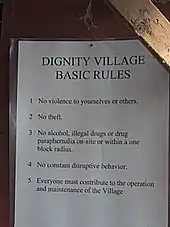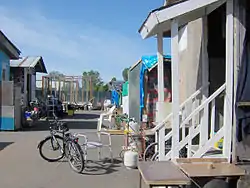Dignity Village
Dignity Village is a city-recognized legal encampment of an estimated 60 homeless people in Portland, Oregon, United States. In the days before Christmas of 2000, a group of transients in Portland established a tent city. It evolved from a group of self-described "outsiders" squatting a city owned land to a self-regulating, city-recognized campground as defined by Portland city code. The encampment is located on a land near Portland International Airport, and has elected community officials and constructed crude but functional cooking, social, electric, and sanitary facilities.[1]
| Part of a series on |
| Living spaces |
|---|
 |
| Squatting in the United States | ||||||
|---|---|---|---|---|---|---|
| International context | ||||||
| Legal acquisition | ||||||
|
||||||
| Housing and justice | ||||||
| Notable squats | ||||||
History
Dignity village was founded by eight transients that pitched five tents on a public land.[2] The squatters then picked up significant media coverage and popular support.[3] It was established in the Sunderland neighborhood near the Portland Airport.[4] The group agreed to pay $2,000 in monthly rent, $17,500 per year for toilets and over $5,000 per year for garbage services.[5]
Repeated attempts to shut down the campsite were rebuffed by the Portland City Council.[6][7] It then guaranteed the community's existence through at least 2010.[8][9] In March 2019, a tiny house exploded at the encampment from its occupant using a leaking propane tank inside the structure. The 8' x 10' structure was destroyed, according to firefighters. A male living in it was injured. [10][11]
Organization

Dignity Village is incorporated in Oregon as a 501(c)(3) membership-based non-profit organization, and is governed by bylaws[12] and a board of directors with an elected chairman and other corporate officers.[13]
Membership is by application review. Dignity Village states that membership is not limited "based on religion, race, sex, sexual orientation, handicap, age, lifestyle choice, previous (criminal) record or economic status."
Because past criminal convictions are not a negative criterion for membership, and because of dangers presented by continuing construction, children are not allowed to reside in the community.[9]
Continued membership is dependent upon following the community's rules of behavior, contained in their membership agreement:[14]
- No violence toward yourself or others.
- No illegal substances or alcohol or paraphernalia on the premises or within a one-block radius.
- No stealing.
- Everyone contributes to the upkeep and welfare of the village and works to become a productive member of the community.
- No disruptive behavior of any kind that disturbs the general peace and welfare of the village.
Membership size varies and is limited by the physical size of the available space at the city yard site. As of January 28, 2016, approximately 60 residents made their home at Dignity Village.[15]
Housing

Designated by the Portland City Council as a transitional housing campground, Dignity Village falls under specific State of Oregon building codes governing campgrounds. This provides a legal zoning status. Lack of building codes has shut down many other shanty town/tent cities in the past. Housing in the Dignity Village community previously consisted of tents, hogans, teepees, light wooden shacks, or more substantial structures built using principles of ecofriendly green construction such as strawbale walls and recycled wood. Light clay straw housing was also built in 2003 as part of the City Repair Project's Village Building Convergence.[16][17]
Community services
Among the services offered by Dignity Village for their residents include:
Gallery
 Deck Shelter at Dignity Village - April 2007.
Deck Shelter at Dignity Village - April 2007. Adobe structure in Dignity Village - April 2007. single-occupancy 10x12-foot structure.
Adobe structure in Dignity Village - April 2007. single-occupancy 10x12-foot structure. Garden in Dignity Village - April 2007.
Garden in Dignity Village - April 2007.
References
- Multnomah.edu Archived September 27, 2007, at the Wayback Machine
- CNN Archived December 23, 2006, at the Wayback Machine
- Busse, Phil (October 9, 2003). "Staying Put--Again: Dignity Village Holds Out and On to Their Homes". Portland Mercury. Retrieved February 16, 2012.
- "Dignity Village". oregonencyclopedia.org. Retrieved 2020-03-11.
- Bayer, Israel (October 13, 2003). "From Doorways to Dignity". Street Roots, via Street News Service. Archived from the original on September 30, 2007.
- Archived May 26, 2006, at the Wayback Machine
- "Mayor Charlie Hales | The City of Portland, Oregon". portlandonline.com. Retrieved July 27, 2016.
- KGW News Archived September 27, 2007, at the Wayback Machine
- Sabatier, Julie (January 11, 2006). "Laura Brown: Life in Dignity Village through the eyes of one longtime resident". Willamette Week. Archived from the original on October 10, 2007. Retrieved February 16, 2012.
- "Tiny home destroyed in propane explosion at Dignity Village in NE Portland". www.msn.com. Retrieved 2019-04-14.
- Burris, Emily , KOIN 6 News (2019-03-06). "Explosion at Dignity Village injures 1". KOIN. Retrieved 2019-04-14.
- Dignity Village
- Campbell, Duncan (October 23, 2003). "America's homeless become new small-town pioneers". The Guardian. Retrieved February 16, 2012.
- Dignity Village
- "DailyGood: Dignity Village: Homes For Portland's Homeless". dailygood.org. Retrieved July 27, 2016.
- "Projects". City Repair. Archived from the original on September 27, 2007. Retrieved April 7, 2009.
- "Dignity Village Builds Straw Bale Housing Prototype". New Connexion. May–June 2003. Archived from the original on November 21, 2007. Retrieved April 7, 2009.
- The Olympian Archived September 27, 2007, at Archive.today
- The Olympian Archived September 20, 2007, at Archive.today